Pillars with Flares - Part 2
Pillars with Flares - Part 2: Exploring the Phenomenon in Detail
In the fascinating world of atmospheric optics, one phenomenon that has captured the attention of sky gazers and scientists alike is the occurrence of pillars with flares. These mesmerizing light displays, observed in various locations around the world, have left many puzzled and intrigued. In this article, we will delve deeper into the topic of pillars with flares, examining the intricacies of their formation and shedding light on some interesting insights.
Unveiling the Mystery: A Closer Look at Flare-Topped Pillars
One notable example of pillars with flares was captured by Aigar Truhin in Sigulda, Latvia. The image, taken from approximately 10 meters above ground level, showcases the awe-inspiring beauty of these phenomena. To gain a better understanding of their nature, Jon Seamans from Redmond, WA conducted ray tracings using HaloSim software. The simulation revealed that the flared shape observed in these phenomena is an upper tangent arc (UTA) caused by horizontal column crystals refracting rays slanting upwards from a light source situated 10 degrees below the horizon.
Exploring Alternative Explanations for Flare Formation
While Jon's simulation provides valuable clues about the formation of flares as UTAs, it raises an important question. If the halo-forming crystals were uniformly dispersed in the air, we would expect the individual tangent arcs formed in different locations to appear at varying angular positions in the sky. This would result in a blurred or featureless glow. However, assuming a special spatial position for the crystals seems unreasonable. So, are there other ways in which distinct UTA flare shapes might form?
To address this question, a rigorous solution to a 3D geometry problem is required. However, we can glean some insights into halo formation and behavior through a simpler approach. By examining the very lowest tip of the UTA formed by light deviated through column crystals by 22 degrees, we can uncover some intriguing details.
Understanding the Geometry of UTA Formation
The crystals responsible for forming the UTA tip lie on a curve in a vertical plane that intersects the eye and the light source. Along this curve, each crystal deviates light from the lamp by 22 degrees. This locus of crystals creates a green line that represents the precise path of light deviation. Additionally, there is a second upper dotted locus for crystals that deviate light by 27 degrees, forming a higher region in the UTA.
Revealing the Halo Source
Examining the rays towards the eye along line B reveals an interesting phenomenon. These rays originate from severely overlapping UTA rays emitted by multiple points above the lower tip. As a result, no distinct halo is visible, except for a possible contribution to the vertical pillar located below the flare.
On the other hand, rays near line A present a different scenario. These rays encounter the tips of UTAs along a gentle curve, reinforcing each other's effect. The corresponding 27-degree curve is initially 5 degrees above the curve for the lower tip, indicating that the UTA shapes overlap minimally and remain relatively undistorted. Crystals within the shaded red region produce distinct UTAs, giving rise to the flare shapes observed in Latvia and the Netherlands.
Validating Predictions: Comparing Measurements and Simulation
To test the prediction regarding the height of flare tips, measurements were conducted on an original image captured in Latvia. Despite some uncertainty in lamp positions, the estimated heights of the lower flare tips on major halos were found to be in close agreement with Jon's simulation. The Deventer halos were also estimated based on lens focal length and the known diameter of the circumscribed halo. Although these measurements are less precise due to variable image scale and less well-defined halos, they still fall within the predicted bounds.
The Flare Shapes Unveiled: A 3D Variant of Upper Tangent Arcs
In conclusion, the flare shapes observed in pillars with flares are essentially three-dimensional variants of upper tangent arcs. Unlike in the case of plate pillars, where halo-forming crystals are located halfway between the observer and the light source, column crystals responsible for flares are found within 20-25% of the distance to the lamp. This revelation eliminates the need for a special crystal location and emphasizes the importance of a thin crystal layer in flare formation. Moreover, the lower tips of flares are positioned 15-22 degrees above the light source, with closer crystals resulting in higher tips. For the halo tips, this corresponds to rays slanting upwards from the light source at angles ranging from 7 to 0 degrees.
The exploration of pillars with flares continues to captivate researchers and enthusiasts alike. Thanks to the systematic work and simulations conducted by Jon Seamans, we have gained valuable insights into the formation and behavior of these enigmatic atmospheric phenomena. As we delve deeper into the realm of atmospheric optics, it is certain that there are still many more intriguing discoveries waiting to be unveiled.
Note: This article has been automatically converted from the old site and may not appear as intended.
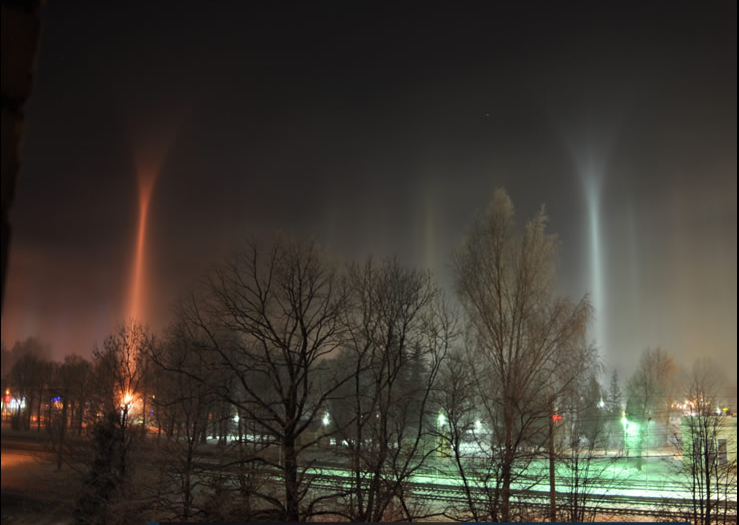
Pillars with Flares - Part 2 - 7 Feb '09
At right - another view of the flare topped pillars seen by Aigar Truhin at Sigulda, Latvia. This image was taken ~10m above ground level. Part 1 and more images here.
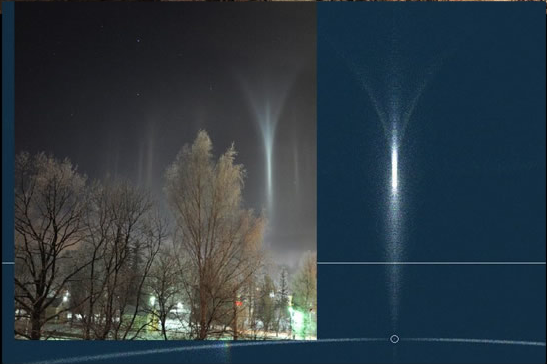
Jon Seamans of Redmond WA did a systematic series of ray tracings with HaloSim to produce the simulation at middle right. The flared shape in the simulation is an upper tangent arc produced by horizontal column crystals refracting rays slanting upwards from a light source that (to the crystals) is 10� below the horizon. The vertical spike in the simulation was from plate crystals but that is not discussed here as the vertical components of Latvia pillars could be formed in other ways.
The apparent match of the simulation is only indicative because artificial light halos come from divergent light whereas HaloSim uses only near parallel rays.
Nonetheless, Jon's simulation gives interesting clues to the flares as a form of upper tangent arcs (UTAs) from upward shining rays. Additional support is provided by the Deventer arcs which were accompanied by a lunar circumscribed halo also formed by column crystals.
There is a problem! If the crystals were everywhere in the air we would expect the individual tangent arcs from crystals in any one locality to appear in a different angular position in the sky to those formed by crystals elsewhere. The set of individual halos might then overlap to form a blur or a relatively featureless glow. To avoid that by assuming a special spatial position for the halo forming crystals is unreasonable. Are there other ways in which distinct UTA, flared, shapes might form?
The answer lies in a rigorous solution of a 3D geometry problem but we can glean some clues of the halo formation and behaviour from an alternative quite simple approach.
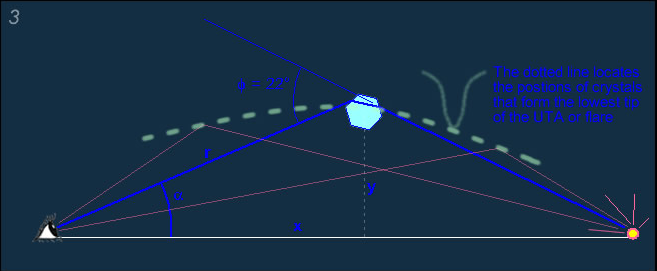
Let's look (Fig 3) at only the very lowest tip of the UTA that is formed by light deviated through column crystals by 22 degrees.
Crystals that form the tip lie on a curve (locus) in a vertical plane intersecting the eye and the light. At each position along the locus a crystal deviates light from the lamp by 22 degrees. For simplicity the light is shown level with the eye but it could be otherwise.
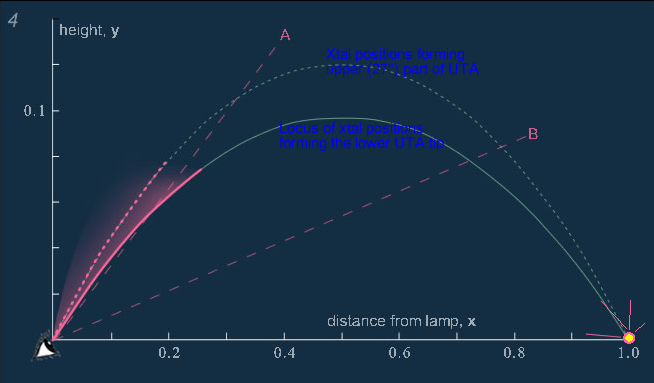
The precise. locus is the green line in Fig 4. The second upper dotted locus is for crystals that deviate light by 27° to form a higher region in the UTA. For clarity the vertical scale in Fig4 is stretched.
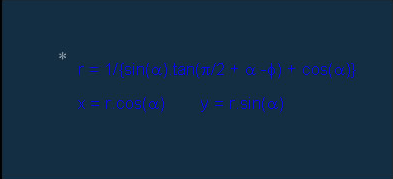
The halo source is now apparent. Rays towards the eye along line B (say) come from severely overlapping UTA rays from many points above the lower tip. No distinct halo is seen except perhaps a contribution to the vertical pillar sometimes below the flare.
Rays to the eye near the line A are different. They see the tips of UTAs along a gentle curve and they reinforce each other. The corresponding 27� curve is initially 5° above that for the lower tip showing that the UTA shapes overlap little and are relatively undistorted. Crystals in the shaded red region produce distinct UTAs, the flare shapes seen in Latvia and Netherlands.
Halos in the shaded red region have their lowest tips 15 - 22° above the source lamp.
To check this prediction, measurements were made on an original Latvia image kindly supplied by Aigar Truhin. There was some uncertainty in the lamp positions but the heights of the lower flare tips on the major halos were estimated as 15.1 and 14.8°. Rays forming the 14.8° lower UTA tip would have come as from 7° below the horizon in reasonable agreement with Jon's simulation.
The Deventer halos were estimated from the lens focal length and also the known diameter of the circumscribed halo. The UTA tip heights are less certain than the Latvia ones because of the variable image scale and less well defined halos. However, they measure 14, 17 and 20° - within the predicted bounds.
To sum up:
The flare shapes are 3D variants of upper tangent arcs. They are formed by column crystals within 20-25% of the distance to the lamp compared with plate pillars where the halo forming crystals are half way. No special crystal location is needed but a thin crystal layer helps. Flares have their lower tips 15-22° above the light source - the closer the crystals the higher is the tip. For the halo tips this corresponds to rays from the light slanting upwards 7 to 0°.
Thanks to Jon Seamans for his systematic work on simulating the halos and subsequent interest and comments. He provided the key.
Note: this article has been automatically converted from the old site and may not appear as intended. You can find the original article here.
Reference Atmospheric Optics
If you use any of the definitions, information, or data presented on Atmospheric Optics, please copy the link or reference below to properly credit us as the reference source. Thank you!
-
<a href="https://atoptics.co.uk/blog/pillars-with-flares-part-2/">Pillars with Flares - Part 2</a>
-
"Pillars with Flares - Part 2". Atmospheric Optics. Accessed on May 2, 2024. https://atoptics.co.uk/blog/pillars-with-flares-part-2/.
-
"Pillars with Flares - Part 2". Atmospheric Optics, https://atoptics.co.uk/blog/pillars-with-flares-part-2/. Accessed 2 May, 2024
-
Pillars with Flares - Part 2. Atmospheric Optics. Retrieved from https://atoptics.co.uk/blog/pillars-with-flares-part-2/.